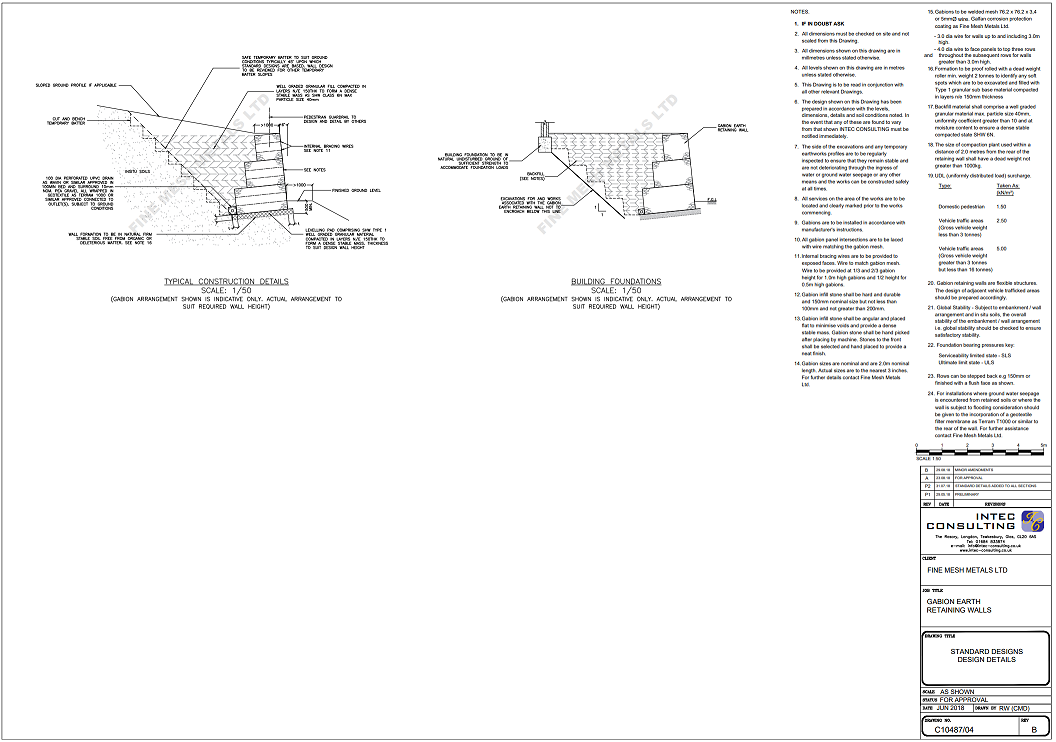Gabion Wall Design Materials and Applications of Gabion Wall
Table Of Content

Regular inspections should be conducted to check for any signs of erosion or vegetation overgrowth. Any eroded areas should be repaired promptly by adding additional rocks or reinforcing the mesh cages. Vegetation should be managed to prevent it from compromising the structural stability of the wall or causing damage to the wire mesh. Before beginning the construction of a gabion retaining wall, thorough site preparation is crucial. This includes clearing the area of vegetation, debris, and any existing structures that may interfere with the wall’s foundation. The gauge of steel as well as the size and type of fill would need to be suitable for the intended purpose.
Slab-on-grade vs foundation and crawlspace or basement
It is assumed that any building foundations on the retained side of the walls will be taken to such as level so as to ensure that no loads are transferred to the Gabions or backfill. The buildingfoundations must not rely on the Gabions or for support, and are outside the scope of simple designs for budget purposes. Various gauges and grades of wire mesh are available, but usually, they’re all galvanized. You can choose a thicker mesh for the bottom and a thinner mesh for the top, as we suggested before, but you can also choose the same thickness for the entire wall if you so desire. To ensure that the eccentricity is within the middle third of the base, its value must be less than one-sixth of the width of the gabion wall at base level. The conclusion was that the gabion wall wins hands down in a comparative match when considering both the climate impact of carbon emissions as well as the financial cost of construction.
Case Studies: Inspiring Projects
Follow the steps outlined below to build a basic freestanding gabion wall on your property. Gabion baskets and the filler materials needed to build a gabion wall are easier to transport than larger stones and bricks. Even after building a gabion wall, you could later disassemble it and move it to a new location in your yard (or elsewhere) with little difficulty.
Erosion Control and Vegetation Management
Gabion retaining walls offer a multitude of benefits that make them an attractive choice for various applications. Firstly, their construction using wire cages filled with rocks allows for excellent water drainage, minimizing hydrostatic pressure behind the wall. You can configure the baskets to make a gabion retaining wall, construct a privacy fence on your property, or simply incorporate (and perhaps even reuse) some natural stone into your home’s garden or yard. Gabion walls also offer a variety of industrial uses, including erosion control, temporary flood control, noise reduction, and filtering silt from water runoff. In residential settings, they are commonly used to create terraced gardens, prevent soil erosion in sloping landscapes, and define boundaries.
Seaside Park Appoints Engineering Firm for 14th Ave. Bayside Repairs - Shorebeat
Seaside Park Appoints Engineering Firm for 14th Ave. Bayside Repairs.
Posted: Fri, 04 Feb 2022 08:00:00 GMT [source]
Their design allows for water drainage.
Some are made with other materials such as oyster shells, wood, bark or recycled glass. The ZEB Pilot house in Norway is a good example incorporating gabion stone cages in home design where they are used to build both interior and exterior walls. If you want to build a particularly tall gabion wall or a stepped wall, the process described above will be more involved and you should consider hiring a contractor. Additional excavation may be needed for a stepped wall, and a backhoe may be required to fill the baskets of a taller gabion wall.
Design of Steel Tanks
This makes sure your wall will have a solid foundation and act as its anchor, as we mentioned before. Although concrete is durable, it has a life span and will show wear and tear over time. Gabion walls have higher wear and tear tolerance and can even grow stronger with time. A high water table might limit your options for a gabion wall too - unless outside and the water streaks and stains add to the aesthetic you're going for. The size of the stones can vary quite a bit from small to large, but the typical diameter you can expect to see is between 4 and 8 inches. From a design point of view, it is worth noting that gabions are not limited to stone.

EXAMPLES OF GABION RETAINING WALLS
If you’re looking for a thinner accent wall for your garden, a gabion wall may not be the best choice. Soil and windblown or water-carried debris may end up in the crevices of the gabion walls. Gabion walls tend to have an industrial look, and it’s harder to make organic shapes with them.
Understanding their impact on the environment can help you make informed decisions and create a green and sustainable landscape. Understanding the financial aspects of a gabion retaining wall project is crucial for effective planning and budgeting. By analyzing the cost factors involved, you can make informed decisions and ensure the successful completion of your project.
You’ll need to assemble the cages, which is relatively straightforward when purchased, but it can take a while if your project requires multiple gabions. That means there’s plenty of room for you to play with how tall you actually want the wall to be. You’ll need to know how tall or thick you want your wall to be before beginning your project, so you know how to construct it accordingly.
Gabion walls have been shown to have about a third of the carbon footprint of a concrete wall. Gabion walls are retaining walls built by stacking stone in a gabion cage or gabion basket that can serve many purposes but are most often used to create tiered or leveled ground in gardens. Gabion wall construction is relatively straightforward, and shorter walls and don’t require heavy equipment. Building a gabion wall is much more straightforward than trying to build a dry stone retaining wall, especially if you have limited construction experience. Fill material can vary from attractive stones to logs, industrial-grade stones, broken concrete, or even slag glass.
For more assistance, reach out to our team of experts or learn more in our tips for building a retaining wall. Insulating the exterior of an existing foundation comes at a much higher cost simply due to the need to excavate, but it does however afford you the opportunity to do a membrane and drainage as well. To do the outside I would propose that you install a dimple drainage matt, along with a weeping tile drained to daylight if you can, and rigid insulation, rockwool or EPS . If you are doing the exterior then you can follow the procedures for exterior insulation here in page about the best way to insulate basements. They are also more frequently being seen installed in urban areas and parks as partition walls or even as outdoor furniture.
Comments
Post a Comment